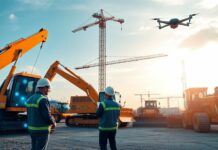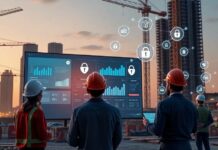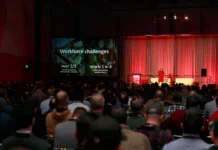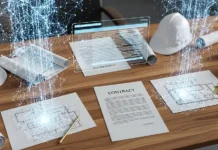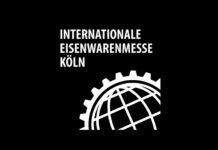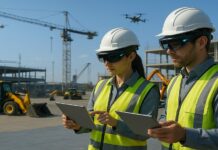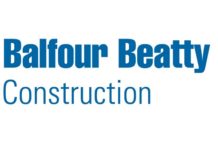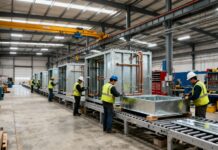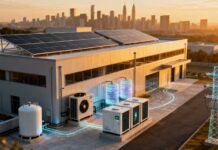The construction industry, long characterized by manual processes, fragmented workflows, and traditional practices, has entered a new era driven by rapid technological innovation. Construction today has entered a new technology-driven era following a period of rapid innovation. PropTech—property technology has transformed the way construction projects are planned, executed, and operated. The move to a digital environment is more than just swapping old tools for new, it is about fundamentally changing the way the construction sector considers efficiency, sustainability, safety, and collaboration within the design and construction sector.
PropTech is a very wide range of technological solutions, such as Building Information Modeling (BIM), Internet of Things (IoT), artificial intelligence (AI), augmented reality (AR), and blockchain, all coming together to make construction smarter, faster, and more sustainable. With the industry being under increasing pressures to lower costs, complete tasks in tighter deadlines, and comply with environmental regulations, the use of these digital tools has become a strategic necessity.
The Evolution of Construction with PropTech
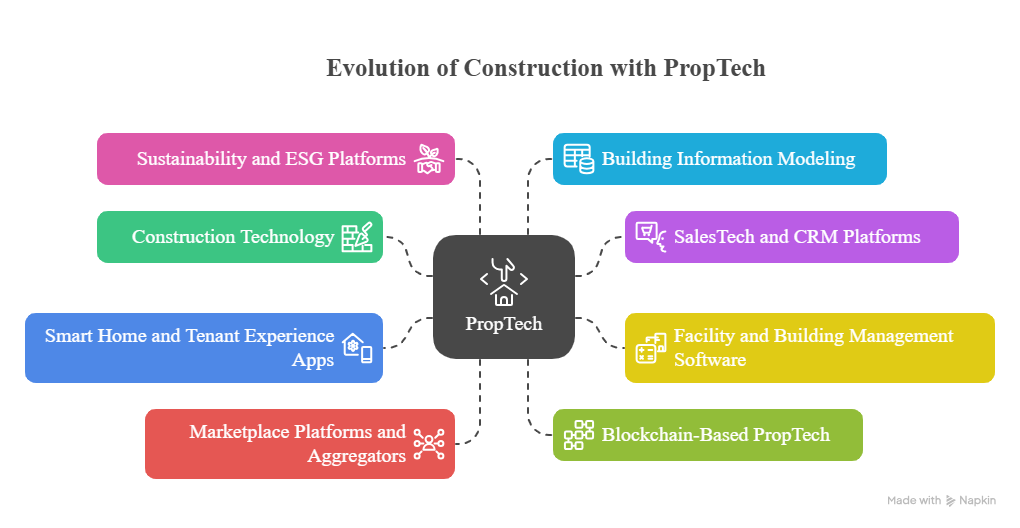
Traditionally, construction relied heavily on paper-based drawings, manual calculations, and isolated workflows. Gaps in communication, absence of real-time data, and minimal automation resulted in delays, cost overruns, and safety problems. In the last few years, though, the incorporation of digital tools has transformed project results.
The development of PropTech may be considered a reaction to pain points in the industry—fragmentation, inefficiency, and risk—by providing solutions that promote transparency, automation, and data-driven decision-making. The change is also aided by developments in cloud computing, mobile technology, and high-speed internet, which provide these tools universally across all stages of the project and geography.
-
Construction Technology (ConTech)
Construction technology, often termed ConTech, is leading the charge to change how the project gets conceived, designed, and built. It represents a vast array of digital technologies, automation, robotics, and data-driven solutions to tackle the age-old inefficiencies and safety risks in the sector. Some of the modern ConTech breakthroughs include modular construction systems, robotic construction equipment, 3D printing, and smart site management platforms.
These technologies facilitate quicker delivery of projects, eliminate wastage, enhance safety levels, and increase accuracy. For instance, robotic masons and autonomous equipment can work in dangerous conditions or do repetitive jobs with high accuracy and speed. In the same vein, 3D printing facilitates on-demand production of building elements, realizing considerable reductions in lead time and wastage of materials.
The combination of ConTech with Building Information Modeling (BIM) makes a virtual twin of the project possible, facilitating real-time collaboration between architects, engineers, and contractors. As ConTech advances, the construction industry becomes a more sustainable, affordable, and capable place to confront future challenges.
-
SalesTech and CRM Platforms
In a competitive real estate development and property management market, Customer Relationship Management (CRM) platforms and SalesTech are key. These computer applications support development and property management professionals by automating lead tracking, customer interactions, and deal management, and providing a unified view of prospects, clients, and project pipelines.
Current CRM solutions involve AI-based analytics to predict market behavior, customize customer interactions, and streamline sales strategies. CRM processes allow for seamless communication across email, phone, social media and have the ability to automate ongoing activities such as follow-up and document sharing. CRM platforms can support virtual site tours and AR showrooms, which can improve buyer engagement particularly within unlicensed distant or international markets.
Through the promotion of data-informed decision-making, leading SalesTech and CRM solutions enhance conversion rates, enhance customer satisfaction, and allow developers and brokers to respond quickly to shifting market conditions.
-
Facility and Building Management Software
Post-construction, building managers and owners are becoming more aware of integrated facility management software. These software offerings help manage maintenance schedules, energy management, security, and comfort for occupants which is increasingly powered in part from a variety of available IoT sensors and automation.
Advanced Building Management Systems (BMS) take real-time data and optimize systems’ operations such as HVAC, lighting, and security to achieve lower operating costs and environmental impact. Property management companies can now also view centralized dashboards to see how systems are operating, run predictive maintenance, and address tenant requests or emergencies with speed.
Analytics also provide actionable insights to enhance tenants’ experience through personalization of the environmental conditions, managing space utilization, and optimizing lease renewals. Facility management software is primed to be the hub of operational excellence and sustainability in what will be smarter buildings.
-
Smart Home and Tenant Experience Apps
The smart home revolution extends beyond single-family residences to multifamily complexes and commercial spaces. Tenant experience apps give control and flexibility to tenants related to amenities, security, healthy living environments, and energy use through an easy-to-use interface typically available on smartphone devices or voice assistants available in the market today.
Using new technology and apps, remote locking/unlocking of doors, reserving common space like BBQ areas, controlling light and temperature levels, and managing maintenance requests through your tenant experience app is now a reality. They promote community interaction with social functionalities and offer landlords real-time access to usage data, allowing for more effective management of resources.
In business environments, tenant experience platforms operate, in buildings, to enhance building operating efficiency through occupancy analytics, adaptive lighting, and environmental controls, while improving tenant satisfaction, reducing operating expenses and supporting sustainability initiatives – all increasingly critical imperatives in today’s competitive real estate markets.
-
Marketplace Platforms and Aggregators
Marketplace platforms and aggregators connect developers and contractors with materials, services, suppliers, and buyers via a shared digital platform. They automate procurement and bidding for projects, resource allocation, and labor connection using transparency in pricing, real-time presence, and reporting and measurement of performance.
Marketplace platforms facilitate smarter sourcing of construction materials, equipment rentals and subcontractor services, while decreasing procurement cycles and costs, comparison bidding, and delivery monitoring to limit exposure and better performance management for project owners.
New generation marketplace platforms and software products leverage AI algorithms to suggest suppliers to project owners based on past supplier performance or sustainability data in line with procurement ESG (Environmental, Social, and Governance) objectives. As data integration becomes more sophisticated, marketplace platforms will serve as crucial tools from which to efficiently and transparently deliver complex construction projects.
-
Blockchain-Based PropTech
Blockchain technology holds the potential to transform property deals, leasing, and asset management with secure, transparent, and impenetrable records. Within PropTech, blockchain supports smart contracts—self-executing contracts that automatically make payments or take actions upon fulfillment of contract conditions.
This technology improves property ownership history transparency, minimizes fraud, and speeds up transaction periods. Smart contracts simplify leasing transactions, automate escrow disbursement, and enable fractional ownership or tokenization of real estate properties, creating new investment opportunities.
Also, blockchain-enabled supply chain tracking guarantees building material provenance, improves compliance, and mitigates conflicts. With greater adoption, blockchain will serve as a backbone for a more efficient, transparent, and trustworthy real estate ecosystem.
-
Sustainability and ESG Platforms
Sustainability and Environmental, Social, and Governance (ESG) considerations are now core to the decisions-making process in real estate and construction. Dedicated platforms are gathering information on energy consumption, the size of carbon footprints, waste management, and social impact measures.
They are designed to enable users to monitor and report on their sustainability performance, set targets, and demonstrate that they are complying with rules/regulations or investors. They also provide the documentation for certified procedures like LEED, BREEAM, or WELL in connecting to detailed information and documentation. As the sustainability standards and requirements continue to evolve, these platforms will play a key role in shaping the responsible development and investment strategies required to meet global climate objectives.
-
Building Information Modeling (BIM)
BIM remains central to the digital transformation of the construction industry. BIM is a three-dimensional computer representation of a building facility’s physical and functional characteristics. BIM allows architects, engineers, contractors, and stakeholders to collaborate on the same platform, providing consistency and reducing errors throughout a project’s life-cycle.
Recent developments in BIM have involved real-time clash detection, automated quantity take-off, and construction lifecycle management. These features facilitate preventative problem-solving capabilities, reduce re-work time, and improve scheduling of projects. BIM also allows for shared data asset information with facilities management and maintenance to improve the utility of the asset beyond construction.
The Future of PropTech and Digital Transformation
The use of PropTech in construction is expected to rise rapidly in the future. More sophisticated, autonomous, and real-time applications will be made possible by the combination of 5G connection, AI, IoT, and edge computing. Intelligent infrastructure management, self-driving construction equipment, and predictive maintenance will become commonplace.
The sector will embrace interoperable platforms more and more, which will form unified data ecosystems that bridge design, construction, and operation stages. This integrated philosophy will enable adaptive, resilient, and sustainable infrastructure that reacts smartly to environmental and societal shifts.
Furthermore, continuous performance monitoring will be made possible by the combination of digital twins and IoT sensors, maximizing asset longevity and operational effectiveness. As the business develops, digital intelligence-driven sustainable practices will become commonplace, helping to meet global climate and resource conservation goals.
Conclusion
PropTech-enabled digital transformation is fundamentally changing the building industry. The PropTech in construction is moving toward a future with greater efficiency, safety, sustainability, and stakeholder interaction as a result of the use of cutting-edge technologies. Despite the obstacles, the ongoing advancement of digital solutions offers hope for a smarter and more resilient built environment.In this new world, players who want to stay competitive and contribute to a wiser, more sustainable world must embrace digital transformation.








